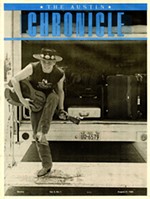Benzene Questions at Crestview Station
Benzene discovered in groundwater under portion of former Huntsman chemical-testing facility property, potential snag for Crestview Station developers
By Lee Nichols, Fri., May 4, 2007

After a year of cleaning up the mess left behind by previous occupants, Trammell Crow Co. and Stratus Properties Inc. appear ready to begin transforming the former Huntsman chemical-testing facility in North Austin into Crestview Station, a mixed-use development adjacent to the planned Capital Metro commuter-rail stop. But they've hit a potential snag: the discovery of benzene in the groundwater under one portion of the property, as well as under a few adjacent houses. Weston Solutions Inc., the company that performed the cleanup, describes the contamination as minor and says it won't harm residents, but a few affected neighbors aren't so sure.
Trammell Crow bought the property in 2005 to take advantage of the city's new transit-oriented development zoning around planned MetroRail stops and hired Weston to raise the environmental conditions of the 73-acre tract to levels considered safe for residential living by the Texas Commission on Environmental Quality. Weston found leaking barrels of what it describes as low-toxicity substances (the facility tested soaps, foams, and glues from 1949 to 2005) and hauled them and tons of the surrounding soil off to a chemical-disposal site. In April, the TCEQ declared all but 3 acres at a southwestern portion of the property safe for housing.
At meetings with neighbors in January and April, Weston reported that benzene-contaminated water was found under those remaining 3 acres. It's believed to have leaked there from an old sewer line, and over 30 to 40 years, the benzene (a chemical carcinogen) had spread into water underneath four nearby homes. Weston and the city of Austin dug six wells around St. John's Circle to test the groundwater; five showed no benzene; one registered a concentration of 3 milligrams per liter. TCEQ residential-area regulations require that action be taken if the level is 0.5 milligrams per liter or higher, unless testing finds that the zone is "saturated soil" – meaning it produces very little water and offers no real potential for direct human contact. In that case, the action level would rise to 6.6 milligrams per liter.
Weston geologist Jeff Henke said his company is still sampling additional water and soil samples. He believes the ground could be classified as saturated because the groundwater is encased in rock underneath several feet of clay and is not a source of drinking water. Basically, Henke told a Crestview Neighborhood Association meeting, as long as people in the affected houses don't drill a well on their property and drink the water – a highly unlikely scenario – there is nothing to worry about. (He also noted that benzene is found in gasoline at around 5,000 to 25,000 milligrams per liter.)
The general mood of the greater neighborhood seems to be welcoming toward Crestview Station, especially since most anti-developer ire is being siphoned off to the other side of Crestview, toward the Northcross Mall/Wal-Mart debacle. "Based on the information provided thus far by Weston, it appears that the depth at which the benzene was found combined with its diluted state work to limit the threat of adverse exposure," said Crestview Neighborhood Association President Chip Harris. "It is a great relief that Huntsman has removed its research and development activities from our neighborhood."
But Weston's explanations haven't satisfied residents living on or very near the underground benzene. Mike Kammlah, who lives a few houses away from the contaminated groundwater, peppered Henke with questions at the meeting, and while Henke had answers, Kammlah remains dubious. "Maybe I'm overdoing it, but I think there's a lot of cover-up here," Kammlah said. "I don't think we're getting the full story. I've asked on several occasions to have the entire test results of the water contamination in our neighborhood, even though every time I do, I get the response that the other contamination is below the recordable number.
"Overall, they're telling us a lot of things I wouldn't even have thought they'd tell us, but [the chemical plant has] contaminated the property underneath our homes, and nothing is going to be done about it, basically. … [They say] the contaminated water is encapsulated – but yet there's water going in. Somehow the water's getting in. So if the water's getting in, then the contamination can get out. I just don't buy it."
Marla Benningfield is downright livid about the situation. She's been living in a house over the contaminated water her entire life and notes that for much of that time, she's been helping her mother fight cancer. Although she is suspicious of what caused her mother's illness (as well as that of other cancer victims and sufferers in the neighborhood), she admits, "I can't link their cancer to benzene." Instead, her main concern is the value of her family's property: "If we try to sell the home, [the benzene] is on record. The value of the property will not be good. … If [my parents] want to move out, they're not going to be able to or be able to get rightfully what's theirs. … Trammell Crow, the city of Austin, Huntsman, and the state … need to come in and clean what's underneath the house."
In a private meeting with Henke, Benningfield says, "We suggested, 'Why don't you go in and pump it out?' … They couldn't really give us an answer on that. … We're not going to stand down because the value of our property is shot to hell." (Henke told us that due to the fractured nature of the rock in which the water is sitting, pumping the water out is extremely difficult, if not impossible.)
Mike Blizzard, a media liaison for Trammell Crow, responded: "If the TCEQ declares this a saturated-soil area – which our scientists tell us it should be – there should be no devaluation of her property at all. In fact, I would argue that the redevelopment of that site and the environmental remediation and the placement of a Capital Metro rail stop there will only enhance her property values." If it's not a saturated-soil area, Blizzard said, there may be a need for a deed restriction against drilling a well, but otherwise the property is unaffected.
"While this isn't a problem that Trammell Crow or Stratus or Weston created," Blizzard said, "they found it in the course of the cleanup and since then have gone above and beyond what is legally required to inform people of what the science says the risks are and what they aren't. It's not easy to be the messenger on this, but it's better for folks to know rather than not know."
*Oops! The following correction ran in the May 11, 2007 issue: In last week's "Benzene Questions at Crestview Station" in the News section, Mike Blizzard was misidentified as "a media liaison for Trammell Crow," one of Crestview Station's developers. Actually, Blizzard is the community-relations consultant for the Crestview Station project but not a direct employee of Trammell Crow. The Chronicle regrets the error.
Got something to say on the subject? Send a letter to the editor.











